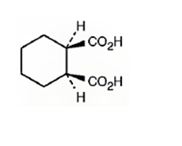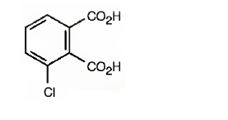
Concept explainers
a) cis-1,2-Cyclohexanedicarboxylic acid
Interpretation:
The structure of cis-1,2-cyclohexanedicarboxylic acid is to be given.
Concept introduction:
The names of simple carboxylic acids which are derivatives of open-chain
To give:
The structure of cis-1,2-cyclohexanedicarboxylic acid.
Answer to Problem 32AP
The structure of cis-1,2-cyclohexanedicarboxylic acid is

Explanation of Solution
The name shows that the compound has a cyclohexane ring with two carboxylic acid groups in 1,2 positions arranged in the same side of the ring.
The structure of cis-1,2-cyclohexanedicarboxylic acid is

b) Heptanedioic acid
Interpretation:
The structure of heptanedioic acid is to be given.
Concept introduction:
The names of simple carboxylic acids which are derivatives of open-chain alkanes are arrived by replacing the terminal –e of the corresponding alkane name by –oic acid. The numbering starts from carboxyl carbon. Compounds with –COOH bonded to a ring are named using the suffix-carboxylic acid. The –COOH carbon in this case is not numbered as C1, instead the carbon to which it is attached is numbered as C1. As a substituent, the –COOH group is called as carboxyl group.
To give:
The structure of heptanedioic acid.
Answer to Problem 32AP
The structure of heptanedioic acid is

Explanation of Solution
The name shows that the compound has a seven carbon straight chain with two carboxyl groups at theb ends.
The structure of heptanedioic acid is

c) 2-Hexen-4-ynoic acid
Interpretation:
The structure of 2-hexen-4-ynoic acid is to be given.
Concept introduction:
The names of simple carboxylic acids which are derivatives of open-chain alkanes are arrived by replacing the terminal –e of the corresponding alkane name by –oic acid. The numbering starts from carboxyl carbon. Compounds with –COOH bonded to a ring are named using the suffix-carboxylic acid. The –COOH carbon in this case is not numbered as C1, instead the carbon to which it is attached is numbered as C1. As a substituent, the –COOH group is called as carboxyl group.
To give:
The structure of 2-hexen-4-ynoic acid.
Answer to Problem 32AP
The structure of 2-hexen-4-ynoic acid is

Explanation of Solution
The name shows that the compound has a six carbon straight chain with a carboxylic group, a double bond between C2 & C3 and a triple bond between C4 & C5.
The structure of 2-hexen-4-ynoic acid is

d) 4-Ethyl-2-propyloctanoic acid
Interpretation:
The structure of 4-ethyl-2-propyloctanoic acid is to be given.
Concept introduction:
The names of simple carboxylic acids which are derivatives of open-chain alkanes are arrived by replacing the terminal –e of the corresponding alkane name by –oic acid. The numbering starts from carboxyl carbon. Compounds with –COOH bonded to a ring are named using the suffix-carboxylic acid. The –COOH carbon in this case is not numbered as C1, instead the carbon to which it is attached is numbered as C1. As a substituent, the –COOH group is called as carboxyl group.
To give:
The structure of 4-ethyl-2-propyloctanoic acid.
Answer to Problem 32AP
The structure of 4-ethyl-2-propyloctanoic acid is

Explanation of Solution
The name shows that the compound is an octane derivative and has a carboxyl group, a propyl group on C2 and an ethyl group on C4.
The structure of 4-ethyl-2-propyloctanoic acid is

e) 3-Chlorophthalic acid
Interpretation:
The structure of 3-chlorophthalic acid is to be given.
Concept introduction:
The names of simple carboxylic acids which are derivatives of open-chain alkanes are arrived by replacing the terminal –e of the corresponding alkane name by –oic acid. The numbering starts from carboxyl carbon. Compounds with –COOH bonded to a ring are named using the suffix-carboxylic acid. The –COOH carbon in this case is not numbered as C1, instead the carbon to which it is attached is numbered as C1. As a substituent, the –COOH group is called as carboxyl group.
To give:
The structure of 3-chlorophthalic acid.
Answer to Problem 32AP
The structure of 3-chlorophthalic acid is

Explanation of Solution
The name indicates that the compound is a benzene derivative with two carboxyl groups on C1 & C2 and a chlorine atom on C3.
The structure of 3-chlorophthalic acid is

f) Triphenylacetic acid
Interpretation:
The structure of triphenylacetic acid is to be given.
Concept introduction:
The names of simple carboxylic acids which are derivatives of open-chain alkanes are arrived by replacing the terminal –e of the corresponding alkane name by –oic acid. The numbering starts from carboxyl carbon. Compounds with –COOH bonded to a ring are named using the suffix-carboxylic acid. The –COOH carbon in this case is not numbered as C1, instead the carbon to which it is attached is numbered as C1. As a substituent, the –COOH group is called as carboxyl group.
To give:
The structure of triphenylacetic acid.
Answer to Problem 32AP
The structure of triphenylacetic acid is

Explanation of Solution
The structure of acetic acid is CH3COOH. The name of the compound given indicates that it has three phenyl groups instead of the three hydrogen atoms present in methyl group in acetic acid.
The structure of triphenylacetic acid is

g) 2-Cyclobutenecarbonitrile
Interpretation:
The structure of 2-cyclobutenecarbonitrile is to be given.
Concept introduction:
Simple open chain nitriles are named by adding –nitrile as suffix to the alkane name, with the nitrile carbon numbered as C1. Nitriles can also be names as derivatives of carboxylic acids by replacing the –ic acid or –oic acid ending with –onitrile. The nitrile carbon is not numbered but the carbon to which it is attached is numbered ac C1. If another carboxylic acid derivative is present in the same molecule, the prefix –cyano is used for the –CN group.
To give:
The structure of 2-cyclobutenecarbonitrile.
Answer to Problem 32AP
The structure of 2-cyclobutenecarbonitrile is

Explanation of Solution
The name shows that the compound has a nitrile group attached to a cyclobutene ring with a double bond between C2 & C3.
The structure of 2-cyclobutenecarbonitrile is

h) m-Benzoylbenzonitrile
Interpretation:
The structure of m-benzoylbenzonitrile is to be given.
Concept introduction:
Simple open chain nitriles are named by adding –nitrile as suffix to the alkane name, with the nitrile carbon numbered as C1. Nitriles can also be names as derivatives of carboxylic acids by replacing the –ic acid or –oic acid ending with –onitrile. The nitrile carbon is not numbered but the carbon to which it is attached is numbered ac C1. If another carboxylic acid derivative is present in the same molecule, the prefix –cyano is used for the –CN group.
To give:
The structure of m-benzoylbenzonitrile.
Answer to Problem 32AP
The structure of m-benzoylbenzonitrile is

Explanation of Solution
The name shows that the compound has a benzene ring attached to a nitrile group and a benzoyl group with meta relationship.
The structure of m-benzoylbenzonitrile is

Want to see more full solutions like this?
Chapter 20 Solutions
EP ORGANIC CHEMISTRY,24 MONTH-OWLV2
- Q8: Draw the resonance structures for the following molecule. Show the curved arrows (how you derive each resonance structure). Circle the major resonance contributor. одarrow_forwardQ9: Explain why compound I is protonated on O while compound II is protonated on N. NH2 DD I II NH2arrow_forwardComplete the following reaction by identifying the principle organic product of the reactionarrow_forward
- Denote the dipole for the indicated bonds in the following molecules. ✓ H3C CH3 B F-CCl3 Br-Cl H3C —Si(CH3)3 CH3 OH HO HO H HO OH vitamin Carrow_forward(a) What is the hybridization of the carbon in the methyl cation (CH3*) and in the methyl anion (CH3)? (b) What is the approximate H-C-H bond angle in the methyl cation and in the methyl anion?arrow_forward10:16 ☑ Vo)) Vo) 4G LTE 76% Complete the following reaction by identifying the principle organic product of the reaction. HO OH ↑ CH2N2 OH ? ○ A. 01 N₂H2C OH ОН B. HO OCH3 OH ○ C. HO OH ŎCH₂N2 ○ D. H3CO OH он Quiz navigation 1 2 3 4 5 11 12 Next page 10 6 7 8 9 10arrow_forward
- Which one of the following statements explain why protecting groups are referred to as “a necessary evil in organic synthesis”? Question 12Select one or more: A. They increase the length and cost of the synthesis B. Every synthesis employs protecting groups C. Protecting group have no role to play in a synthesis D. They minimize the formation of side productsarrow_forwardWhich of the following attributes is a key advantage of the chiral auxiliary approach over the chiral pool approach in asymmetric synthesis? Question 10Select one: A. Chiral auxiliaries are cheaper than chiral pool substrates B. Chiral auxiliary can be recovered and recycled unlike chiral pool substrates. C. The use of chiral auxiliaries provide enantiopure products, while chiral pool reactions are only enantioselective D. The chiral auxiliaries are naturally occurring and do not require synthesisarrow_forwardIn the following molecule, indicate the hybridization and shape of the indicated atoms. CH3 CH3 H3C HO: CI:arrow_forward
- Which of the following are TRUE about linear syntheses? Question 7Select one: A. They are easier to execute B. They are the most efficient strategy for all syntheses C. They are generally shorter than convergent syntheses D. They are less versatile compared to convergent synthesesarrow_forwardWhich of the following characteristics is common among chiral pool substrates? Question 4Select one: A. They have good leaving groups B. They are all achiral C. All have a multiplicity of chiral centres D. They have poor leaving groupsarrow_forwardDetermine whether the following reaction is an example of a nucleophilic substitution reaction: H NO2 H+ NO 2 + Molecule A Molecule B Is this a nucleophilic substitution reaction? If this is a nucleophilic substitution reaction, answer the remaining questions in this table. What word or two-word phrase is used to describe the role Molecule A plays in this reaction? What word or two-word phrase is used to describe the role Molecule B plays in this reaction? Use a 6 + symbol to label the electrophilic carbon that is attacked during the substitution. Highlight the leaving group on the appropriate reactant. O Yes ○ No ☐ 0 dx 000 HE ?arrow_forward
 Chemistry: Principles and ReactionsChemistryISBN:9781305079373Author:William L. Masterton, Cecile N. HurleyPublisher:Cengage Learning
Chemistry: Principles and ReactionsChemistryISBN:9781305079373Author:William L. Masterton, Cecile N. HurleyPublisher:Cengage Learning

